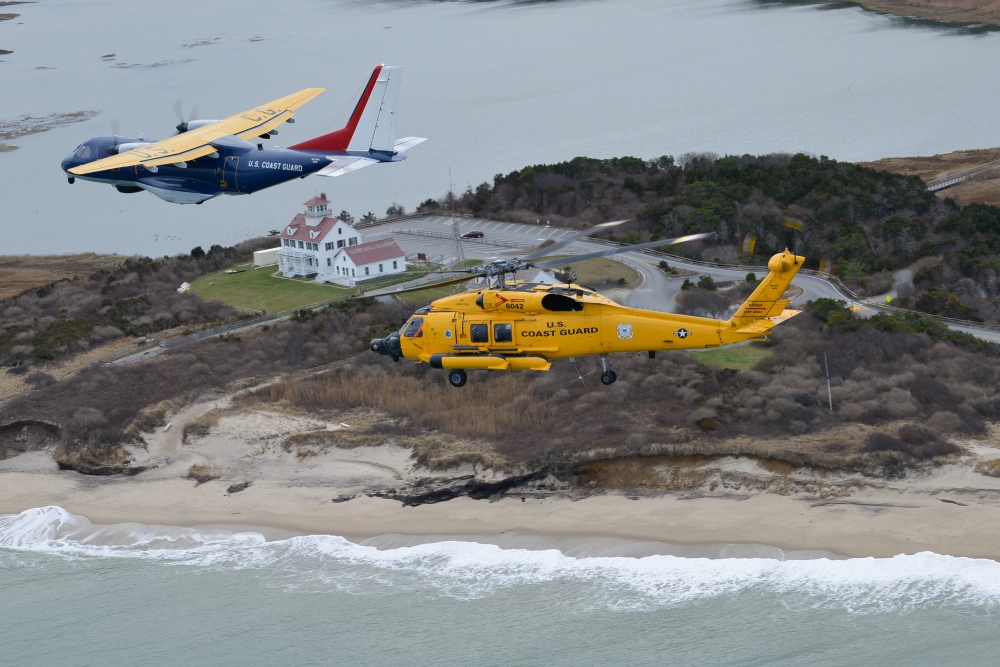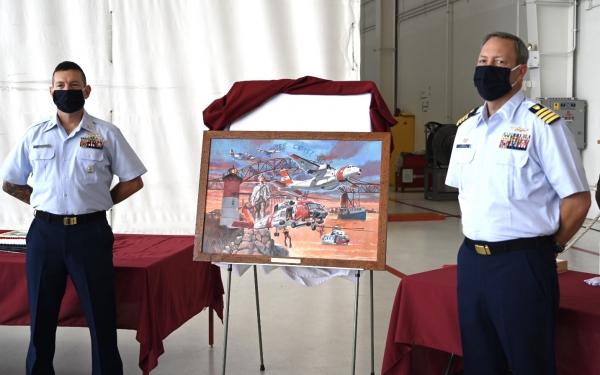Sideways sleet and fog so thick you can’t see your hand in front of your face aren’t operational hazards reserved solely for Alaska’s rugged duty stations.
“There’s lots of snow, ice, rain, and fog up here,” explained Air Station Cape Cod pilot Lt. William Martin. “Many affectionately refer to us as Cape Cloud.”
Coast Guard Air Station Cape Cod recently commemorated 50 years of answering the call in every combination of weather extreme, ranging from tropical storms in the summer and harsh nor’easters in the winter.
 |
| Artifacts brought from the Coast Guard museum on Cape Cod at Air Station Cape Cod August 28, 2020. During the Coast Guard Air Station Cape Cod 50th anniversary, the museum brought items belonging to Elmer F. Stone, naval aviator and commander in U.S. Coast Guard. (U.S. Coast Guard photo by Petty Officer 2nd Class Amanda Wyrick) |
This combination of challenges in a cold weather climate attracts pilots - specifically fixed-wing pilots - to East Coast operations. In fact, Air Station Cape Cod is one of the only winter weather climates outside of Alaska. Members of the aviation community hoping to be assigned to the Coast Guard’s Seventeenth District often seek out Cape Cod as a strategic stepping-stone for future assignments.
“It’s a tremendous responsibility that we have here at Air Station Cape Cod because we’re the only air station in the totality of district one,” said Martin. “We get to see a lot of different kinds of search and rescue missions—we get them all. Recreation boaters and mariners are just some of the individuals the men and women of Air Station Cape Cod serve daily.”
Air station crews cover a lot of ground from high above. Air Station Cape Cod’s area of operation reaches from the Canadian border from New York to Maine to just south of the Long Island Sound, reaching out as far west as Lake Champlain.
“Anyone can have a bad day, even experienced boaters,” said Martin. “But it’s always a great day when we can help anyone at all who has found themselves in the midst of trouble.”
The proximity to the Eastern Seaboard’s high-volume ports in Boston, New York, and Portland, Maine, results in a high volume of cruise ship medevac flights.
“We do a lot of hoists from the big active ports,” explained Martin. “Getting to see some patients through to the [hospital] is a nice perk we have here and reminds us why we do the job in the first place.”
Fixed-wing pilots are not the only ones benefiting at Air Station Cape Cod. “Our helicopter training is top-notch here,” said Martin. “Pilots are able to get their feet wet up here and then move on to other cold weather stations like Alaska.”
 |
| The centennial HC-144 Ocean Sentry airplane and MH-60 Jayhawk helicopter fly over a retired Coast Guard station museum at Coast Guard beach, Eastham, Massachusetts, Monday, Dec. 16, 2019. Coast Guard Air Station Cape Cod will celebrate 104 years of aviation in Mass., and 50 years on Cape Cod. (U.S. Coast Guard photo by Petty Officer 2nd Class Nicole J. Groll) |
The rich history of Air Station Cape Cod, in combination with the grit of its aircrew members, was celebrated in earnest by all in attendance for the station’s 50-year commemoration. The members of Air Station Cape Cod’s fixed-wing crew of rescue plane 2313 were acknowledged as Commander Elmer F. Stone Award winners, which is representative of the type of rigorous training members receive at Air Station Cape Cod, as well as and top-notch maneuvering the men and women of Air Station Cape Cod deliver on a daily basis. Read about these winners on MyCG’s article, Aerial Heroism: The 2020 Aviation Award Winners.
The commemoration ceremony included the unveiling of a mural, designed by local artist Brian Snufner, and a commemorative military patch for the base designed by Lt. j.g. Brendan Flynn and Petty Officer Second Class Nick Becton, an aviation maintenance technician at Air Station Cape Cod.
 |
| Command Master Chief Jacob Linder and Capt. Scott Langum, commanding officer, Air Station Cape Cod, stand next to a painting to commemorate the 50th anniversary of the air station. The groundbreaking ceremony took place August 29, 1970, and a few weeks later the first aircrafts were transferred from the base in Salem and Rhode Island. (U.S. Coast Guard photo by Petty Officer 2nd Class Amanda Wyrick) |